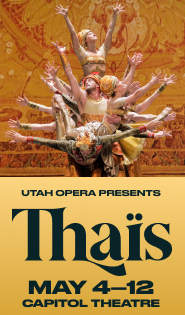Fischer, Utah Symphony tackle Messiaen’s strange yet compelling “Turangalîla”

Throughout his tenure as music director of the Utah Symphony, Thierry Fischer has earned a reputation for curating eclectic concerts that juxtapose contrasting pieces. It is therefore notable that three of his last four concerts as music director feature only one piece each. In March, he led the orchestra in Bruckner’s Symphony No. 5, his final concerts this week will feature Mahler’s Symphony No. 3, and Friday night, he led the Utah Symphony premiere of Oliver Messiaen’s Turangalîla-Symphonie.
Of those three monumental pieces (each clocking in at 70-90 minutes), the Messiaen might be the most challenging for both orchestra and audience. From the orchestra, it required extra personnel, including four additional percussion players for a total of eight and a guest artist—French musician Augustin Viard—to play an unwieldy electronic instrument called the ondes Martenot. From the audience, the work required a willingness to suspend preconceived notions of rhythm, harmony, form, and style and follow the orchestra on Messiaen’s mystical journey.
For those willing to make the trip, Fischer and the orchestra proved brilliant guides, imbuing the piece’s strange twists and turns with lucidity and charm, creating moments of exquisite beauty along the way.
Principal keyboardist Jason Hardink took a leading role, playing a piano placed in front of the orchestra, concerto style, without a score and displaying a remarkable affinity for the piece’s unique aesthetic. Remaining loose and relaxed, he brought dazzling technique, attacking the cacophonous runs and with precision and intensity, while staying true to the piece’s big ideas.
In certain passages, Hardink seemed to lean into the piece’s absurdism, giving a boisterous energy to moments like the first movement’s extended ostinato passages that twittered over lumbering half notes in the low brass; likewise at the end of the sixth movement, where the strident piano line seemed to be speaking a different language from the lush strings surrounding it. In other moments, like the same movement’s contemplative opening passage, he played with soulful and earnest sensitivity.
While the ondes Martenot was in front of the orchestra next to the piano (with four oddly shaped speakers), it took more of a background, ambient role, adding an otherworldly sound to the overall texture. The few times it took a solo passage, the sound called to mind an old-timey radio searching for a station, and/or the score of a low budget television show set in outer space.
Fischer and the orchestra established their Messiaen bona fides last season with another of his major, multi-movement works: Des canyons aux etoiles, which they performed in two subscription concerts, in an outdoor concert at Zion’s national park, and on a recording released by Hyperion. This familiarity served them well, as they deftly navigated the Turangalîla’s stylistic shifts and contrasting textures.
Though certain melodic and harmonic motives recurred throughout the piece, each of the ten movements stood apart as a self-contained statement with a distinct mood. Constant throughout was a seeming struggle between consonance and cacophony, with the large, varied percussion section (including blocks, maracas, a loud bass drum and a variety of melodic instruments) playing both sides.
There were passages calling to mind Gershwin’s American in Paris, Copland’s Billy the Kid, and Bernstein’s dances from West Side Story—all of which were written within a decade of the Messiaen—but dissonance and the dissolution of tonality was never more than a few bars away, and often occurred at the same time, undergirding the melodies with a sense of foreboding.
It was a testament to the orchestra’s cohesion that they were able to stay together through these passages and produce some beautifully transparent textures and orchestral colors. High points included “Jardim du sommeil d’amour,” which began with contemplative mood in the piano and percussion, grew into a lush warm melody in the strings, and then devolved into a cacophonous three-part counterpoint. That movement also showcased the musicality of the strings, winds and brass, which created well-phrased melodic lines that were independent of one another and came together in the end.
At the end of the piece, the audience responded with a mixture of elation and bemusement, but no one left untouched by Messiaen’s strange yet compelling opus.
In his final concerts as music director Thierry Fischer leads the Utah Symphony in Mahler’s Symphony No. 3, 7:30 p.m. Friday and Saturday. utahsymphony.org

